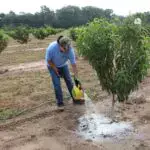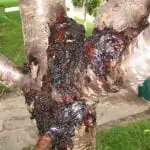Learn how beneficial nematodes can help you protect your fruit trees from plum curculio and other pests.
5 Steps to Preparing Fruit Trees for Winter (and Preventing Winter Damage)

As winter approaches, fruit tree growers need to prepare their trees for the cold weather. Without protection, fruit trees are vulnerable to frost damage, which can harm or even kill fruit trees. In this article, we'll learn how to prepare fruit trees for winter. We'll cover root, branch, and bark protection.
So, let's dig in!
Preparing fruit trees for winter step 1: Insulating root systems
Insulating root systems is essential when preparing fruit trees for winter. This process protects the tiny feeder roots, or root hairs, which absorb water and nutrients from the soil. Freezing temperatures can kill these fine roots, leading to tree stress and, in severe cases, even tree death.
How to winterize your fruit tree: To insulate the root system, apply a layer of mulch around the base of the tree. There are various mulch options available, such as bark mulch or straw. Arborist wood chips are also a popular option. But, avoid using compost or rotted manure in the fall, as these nutrient-rich mulches can stimulate the tree's growth, potentially delaying dormancy.

Preparing fruit trees for winter step 2: protecting the trunk
Believe it or not, fruit trees can get sunburned, especially in winter. Sunlight reflecting off the snow can heat the trunk, causing it to expand during the day. At night, when temperatures drop, the trunk contracts, leading to cracks that can’t heal while the tree is dormant.
These cracks expose the cambium layer, the living tissue beneath the bark, to cold. This creates openings for pests and diseases. The unprotected cambium can also be damaged by extreme cold, causing cells to burst and potentially leaving lasting damage to the tree.
During the winter, young and newly planted trees are especially vulnerable to wildlife damage. With less food available, hungry rabbits and rodents often see tender young fruit tree bark as a tasty snack.
How to winterize your fruit tree: To protect your tree from sun scald, paint the trunk with a mix of 50% white latex paint and 50% water. This white coating reflects the sun and shields the bark. You can also use white plastic spiral tree guards (affiliate link) or wrap the trunk with kitchen foil. To protect against rabbits, put up a simple rabbit and rodent fence. Remember to remove the plastic guards or foil in early spring, or you might find insects breeding underneath!
Preparing fruit trees for winter step 3: defend against insects and diseases
Fruit tree pests and diseases can harm your tree’s health and productivity. The best time to prevent this is in the fall. Insects and pathogens often overwinter in fallen leaves and fruit under the tree. By removing this debris, you reduce the pest population and prevent disease spread in spring and summer.
Also, you may notice immature shrivelled fruit, known as “fruit mummies,” on your tree. It's best to remove these fruit mummies as they can harbor disease spores.
How to protect your fruit tree:
To guard against overwintering pests and diseases, rake up all fallen leaves and fruit debris from under the tree’s canopy and remove them from the site (don’t add them to your compost!). This prevents insects and disease spores from overwintering and returning in the spring.
Preparing fruit trees for winter step 4: continue irrigating in the fall
Watering fruit trees well in the fall is key to winterizing them. Fruit trees take in nutrition in liquid form from the soil. So hydration helps trees store nutrients in their roots, supporting their health and survival. Well-watered trees are less prone to winter damage because water in the cells insulates them, reducing the risk of freezing.
How to winterize your fruit tree: To ensure proper hydration, continue to water fruit trees until a few weeks before the ground freezes. This practice allows the trees to build up nutrient reserves for winter storage in the roots. Monitoring soil moisture and adjusting watering frequency accordingly is essential. You will stop watering fruit trees well in advance of freezing temperatures to prevent ice formation on the roots.
Fruit Trees
That Thrive

Preparing fruit trees for winter step 5: avoid fall pruning
When it comes to fruit tree pruning, your timing makes all the difference. While pruning in late winter or spring is often beneficial, fall pruning can be harmful. Pruning cuts create wounds, and during the growing season, protective cells form to help the tree heal.
But that doesn't happen in the fall, when tree growth has slowed down. At that time of year, these cells don’t form as effectively. Fall pruning can also stimulate new growth that may not harden before winter, leaving it vulnerable to frost damage and creating entry points for pests and diseases.
How to protect your fruit tree: Avoid pruning in the fall. Instead, learn when to prune your fruit tree for the best results. Prune in the dormant season or early spring to encourage growth and allow for better healing. For large trees, prune in early summer to reduce size. By avoiding fall pruning, you minimize the risk of creating wounds and help your fruit trees stay strong and healthy.
Is wrapping fruit trees for the winter necessary?
Most fruit tree species are naturally hardy and they have evolved to endure various environmental conditions, including cold winters. For instance, there are some cold hardy apples can be grown in very cold climates.
And unlike some ornamental trees, most fruit trees can withstand winter's challenges. The most important thing to consider is that you purchase a fruit tree that is well adapted to your specific climate and you can learn more about that in the Orchard People course Researching Fruit Trees for Organic Growing Success.
How to winterize your fruit tree: In most cases, fruit trees do not require wrapping for winter protection.
Protecting your fruit tree for winter helps ensure a healthy harvest in the year to come
For any responsible grower, preparing your fruit trees for winter is important. Extreme cold can be a problem but with proper preparation, our trees can withstand the chill. With a little help from us, those trees will make it safely through the winter and be ready to produce a wonderful organic harvest for us in the growing season to come.

Susan Poizner
Learn more about Susan on the about us page.



